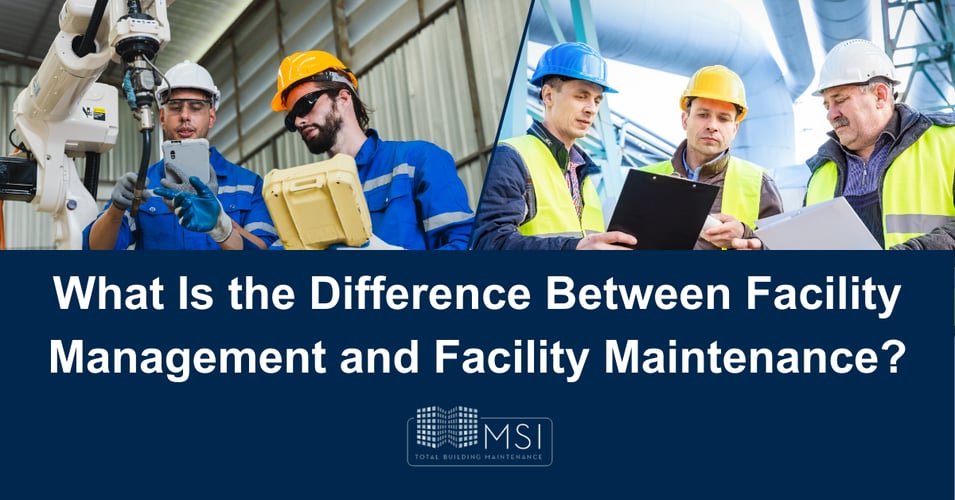Difference Between Facility Management and Facility Maintenance?

Table of Contents
Running a successful business requires careful management and maintenance of facilities. However, this raises an important question: what is the difference between facility management and facility maintenance? Understanding these differences can help facility managers and maintenance professionals optimize their operations and ensure the smooth, efficient functioning of their buildings. Below, we explore the distinctions between these two important functions and provide valuable insights into how each contributes to overall facility efficiency.
What Is the Difference Between Building Maintenance and Facilities Management?
Facility management and maintenance are often used interchangeably, but they serve different purposes in the upkeep and operation of a building.
What is facilities management?
Facilities management encompasses a broader scope of responsibilities that includes strategic planning, project management, and services that support the functionality, comfort, safety, and efficiency of a building. It involves coordinating various aspects such as space allocation, emergency preparedness, and compliance with regulations.
What is building maintenance?
On the other hand, building maintenance focuses on the upkeep of a facility’s physical structure and systems. This includes routine tasks like HVAC servicing, plumbing repairs, electrical inspections, and general cleaning. While maintenance is a component of facility management, its approach is more hands-on and immediate.
Facility management is strategic and proactive, aiming to enhance the overall performance and value of a facility. On the other hand, maintenance is tactical and reactive, addressing issues as they arise to ensure the facility remains operational.
What Are the 2 Major Types of Facilities Management?
The contents of a facility management services list can be divided into two major categories: Hard FM and Soft FM.
Hard FM refers to anything related to the management of physical infrastructure and assets, including electrical systems, plumbing, HVAC, and building maintenance. These services ensure that the facility's physical aspects are functional and well-maintained.
Soft FM, on the other hand, covers services that make the environment more pleasant and supportive for the occupants. This includes cleaning services, landscaping, security, waste management, and catering. While Hard FM is essential for the structural integrity and safety of the building, Soft FM focuses on enhancing user experiences by creating a comfortable, efficient workspace.
By combining both types of facility management, organizations can create a balanced approach that addresses both the physical and experiential needs of their facilities.
What Do You Mean by Facilities Management?
Facilities management is the integration of processes and services that support the safety, sustainability, and efficiency of buildings and real estate. As a result, it typically involves coordinating people, processes, and technology to ensure effective operation of the built environment.
Facility management examples include space planning and allocation, energy management, asset management, and ensuring compliance with health and safety regulations. It also involves managing vendor contracts, overseeing renovation projects, and implementing sustainability initiatives.
Effective facilities management plays an essential role in enhancing the productivity and well-being of occupants, reducing operational costs, and extending asset lifespans. It also requires a holistic approach that takes both the strategic and operational aspects of overseeing a facility into consideration.
What Are Facility Maintenance Procedures?
Facility maintenance procedures are the specific tasks and activities carried out to ensure the proper operation and longevity of a facility's physical assets. This includes routine inspections, preventive maintenance, and corrective repairs.
Preventive maintenance involves scheduled activities aimed at preventing equipment failures and keeping assets functional for as long as possible. This includes tasks like lubricating machinery, replacing worn-out parts, and conducting regular inspections.
On the other hand, corrective maintenance focuses on addressing issues as they arise, such as fixing a broken HVAC system or repairing a leaky roof. It is reactive in nature and focuses on restoring functionality as quickly as possible.
What is maintenance management?
Proper maintenance management involves creating a comprehensive plan that outlines all maintenance activities, schedules, and responsibilities. This ensures that all assets are regularly inspected, maintained, and repaired, overall minimizing downtime and maximizing efficiency.
Conclusion
Understanding the difference between facility management and facility maintenance is essential for optimizing building operations and ensuring a safe, reliable, and comfortable environment for occupants. Facility management takes a strategic approach, focusing on the overall performance and sustainability of the facility, while maintenance is more tactical, addressing the immediate needs of the building's physical assets.
By effectively integrating both facility management and maintenance, organizations can create a well-rounded approach that enhances productivity, reduces costs, and extends the longevity of assets. If you're looking to improve your facility management practices, consider reaching out to a professional service provider like Managed Services Inc. We offer a comprehensive range of services that can help you achieve your facility management goals.
Interested in learning more about commercial building maintenance? Check out our related articles and resources to explore further.
Learn more about our facility management services here.






